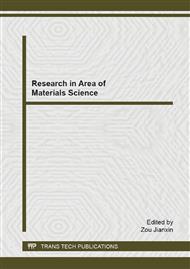p.340
p.346
p.351
p.356
p.360
p.366
p.371
p.376
p.381
Colossal Permittivity Observed in Yttrium Doped BaTiO3
Abstract:
Colossal permittivity (CP) in BaTiO3 (BT)-based polycrystalline ceramics with normal grain sizes has been successfully obtained in yttrium (Y) doped BT ceramics (BYT) via a simple and effective method. Considering the necessary factors for CP formation mechanism, well designed doping condition and sintering procedure were carried out in the sample preparation. Characterizations show that BYT is with a pure tetragonal perovskite structure and the grain growth is depressed under the action of Y donor doping. The frequency independence of permittivity and Debye-like relaxation related to Maxwell-Wagner relaxation which occurred at the interfaces between semiconducting grains and insulating grain boundaries can be detected. These are induced by an internal barrier layer capacitance (IBLC)-type structure which formed under an overall and carefully designed synthesis procedure. But the temperature independence of permittivity does not arise because of the particular tetragonal structure and micron dimension grain sizes of BYT.
Info:
Periodical:
Pages:
360-365
Citation:
Online since:
April 2015
Authors:
Keywords:
Price:
Сopyright:
© 2015 Trans Tech Publications Ltd. All Rights Reserved
Share:
Citation:


